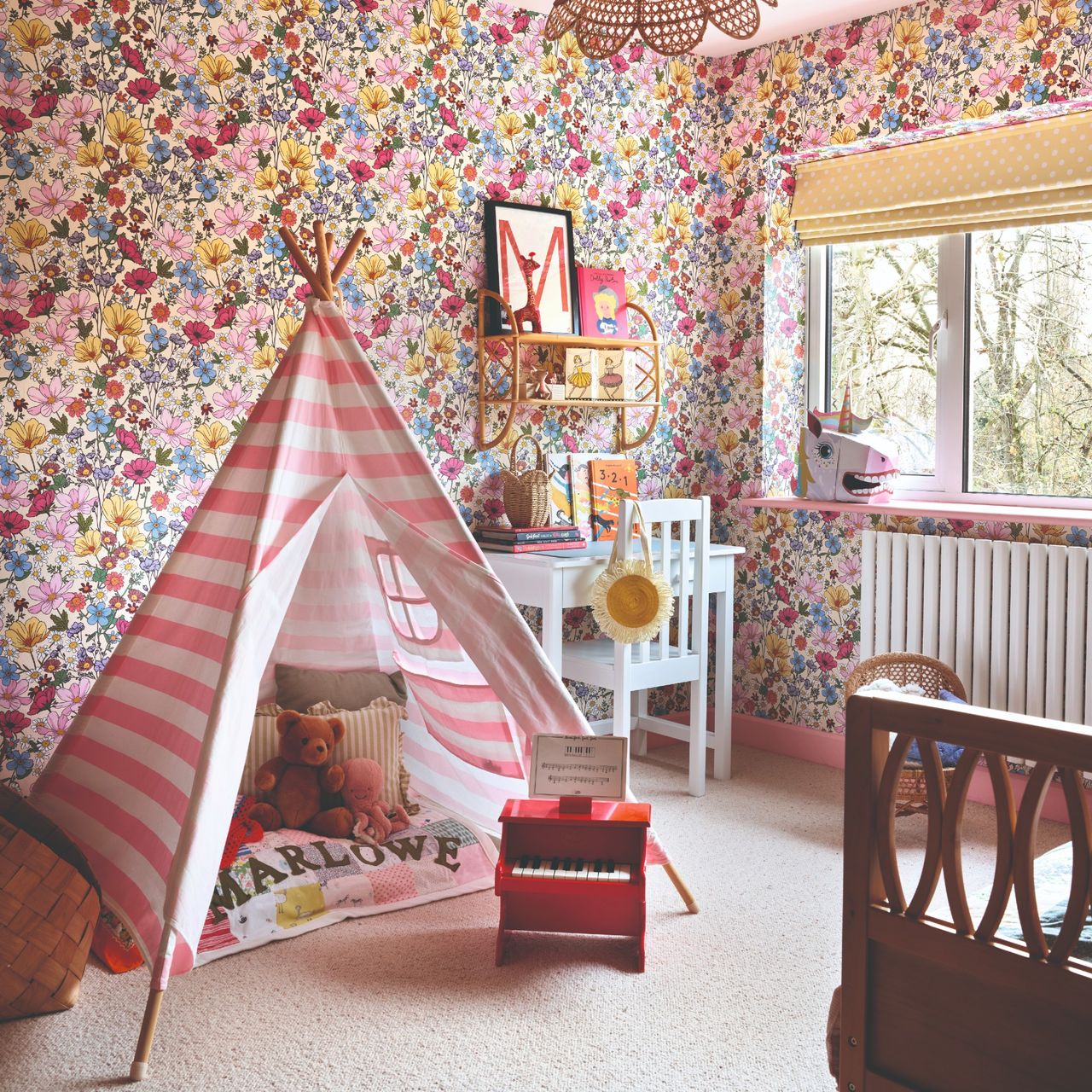
Your children’s (or child’s) playroom is the one area in your home that should be all about them. A space designed for play and fun that encourages creativity, creates a sense of adventure and inspires imaginative play while also ticking some practical requirements – all of which our clever playroom ideas take into consideration and take care of.
While it’s ideal for the playroom to be its own self-contained space, these tips also work if the play zone is within your children’s room or the family living room if your home’s space doesn’t allow otherwise. Either way, dedicating zones to various activities and coming up with enough toy storage ideas is key.
‘A perfect playroom strikes a balance between function and creativity,’ says Debbie Leigh, design manager at ILIV. ‘It should be a space that supports imaginative play, encourages learning and evolves as a child grows. Flexibility is key.’
Playroom ideas
‘A perfect playroom is like stepping into a little universe of its own, bursting with creativity, a delightful kind of chaos, and just a sprinkle of magic,’ confirms Sam Sutherland, Flitch interior stylist. ‘It should inspire open-ended play, be a breeze to clean up, and evolve as your child grows.’
1. Incorporate soft finishes
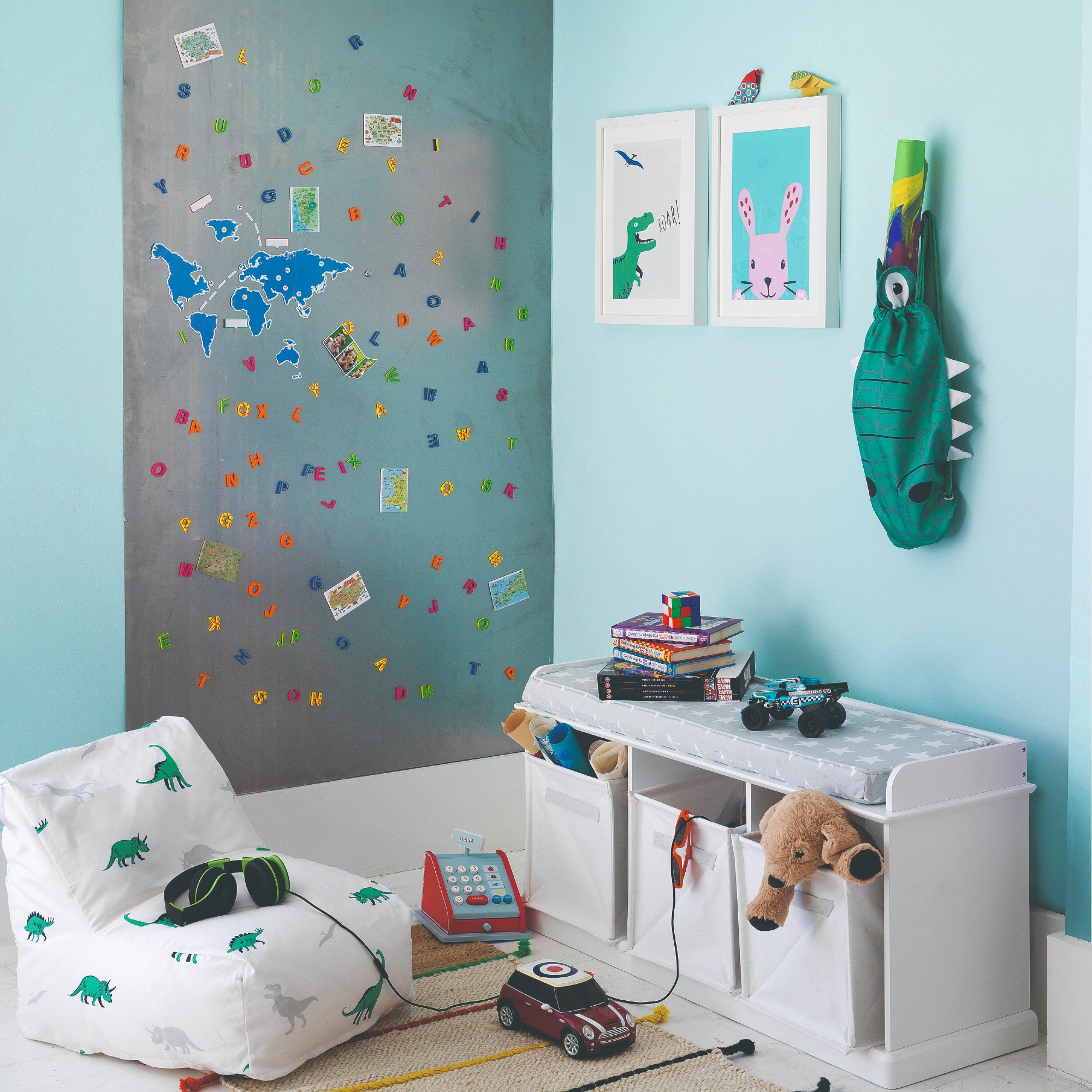
Whether it’s small playroom ideas you’re after or your little ones’ play space has quite a lot of room, a playroom should feel cosy – and it’s soft textures and finishes that will provide that feel.
‘Soft textures like cushions, rugs and upholstered chairs can help with sound absorption and create a sense of comfort, especially in busy family homes. Cosiness comes from layering. Soft floor cushions, warm textiles and tactile fabrics like brushed cottons or velvets can all contribute,’ Debbie at ILIV says.
Sam at Flitch agrees, ‘Cosy up your space with some soft furnishings. Think cushions, beanbags, a fluffy rug, and curtains that gently diffuse the light.’
2. Include multifunctional pieces
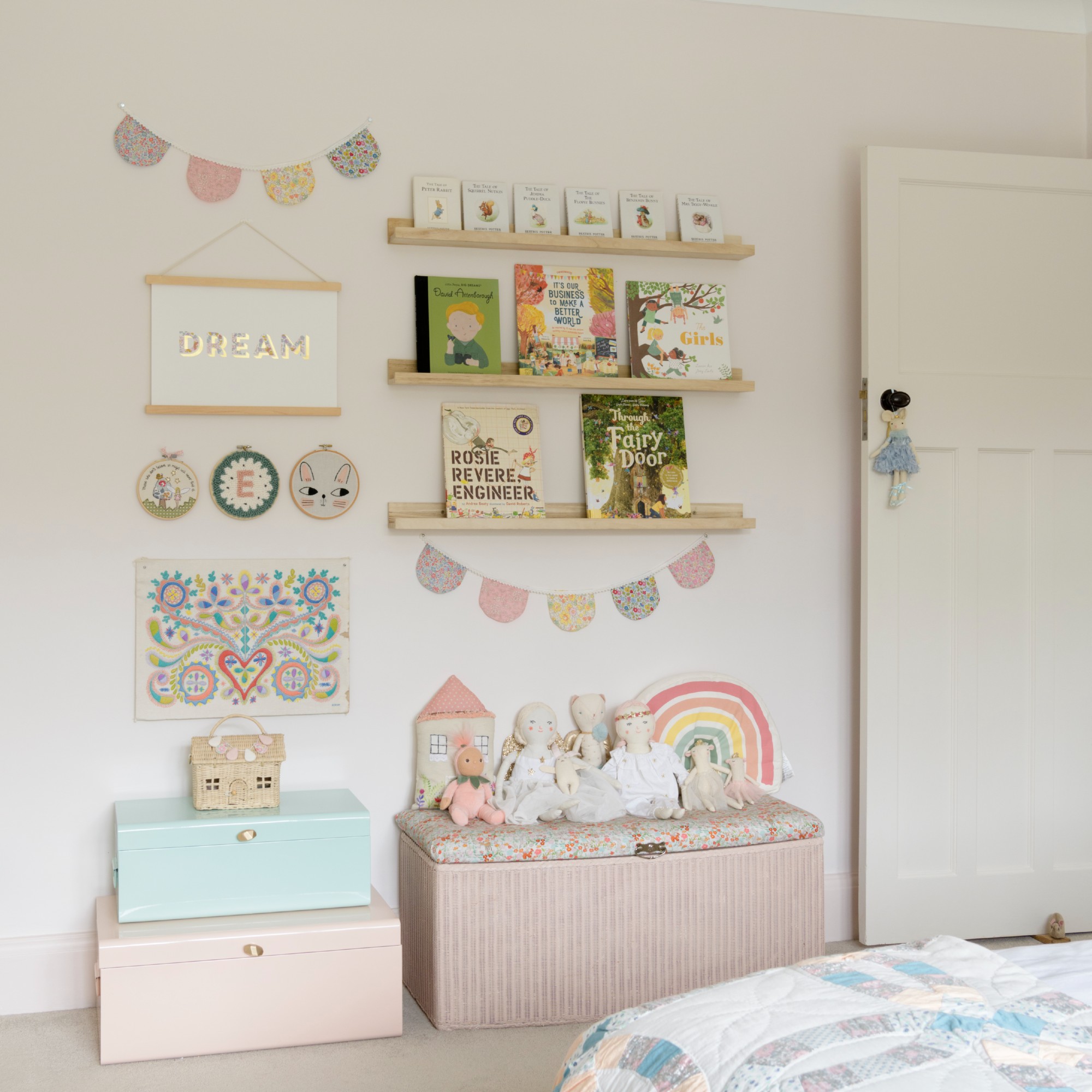
As already mentioned - and as we’re sure you know very well - a good playroom needs plenty of storage solutions for toys, arts and crafts supplies and more. And while some storage can be on display, in order to avoid a cluttered look, it’s best to invest in some hidden storage solutions as well.
‘Organisation starts with smart storage so it’s important to include baskets, cubbies, and multi-purpose furniture like upholstered benches with hidden compartments,’ Debbie at ILIV says.
3. Create zones
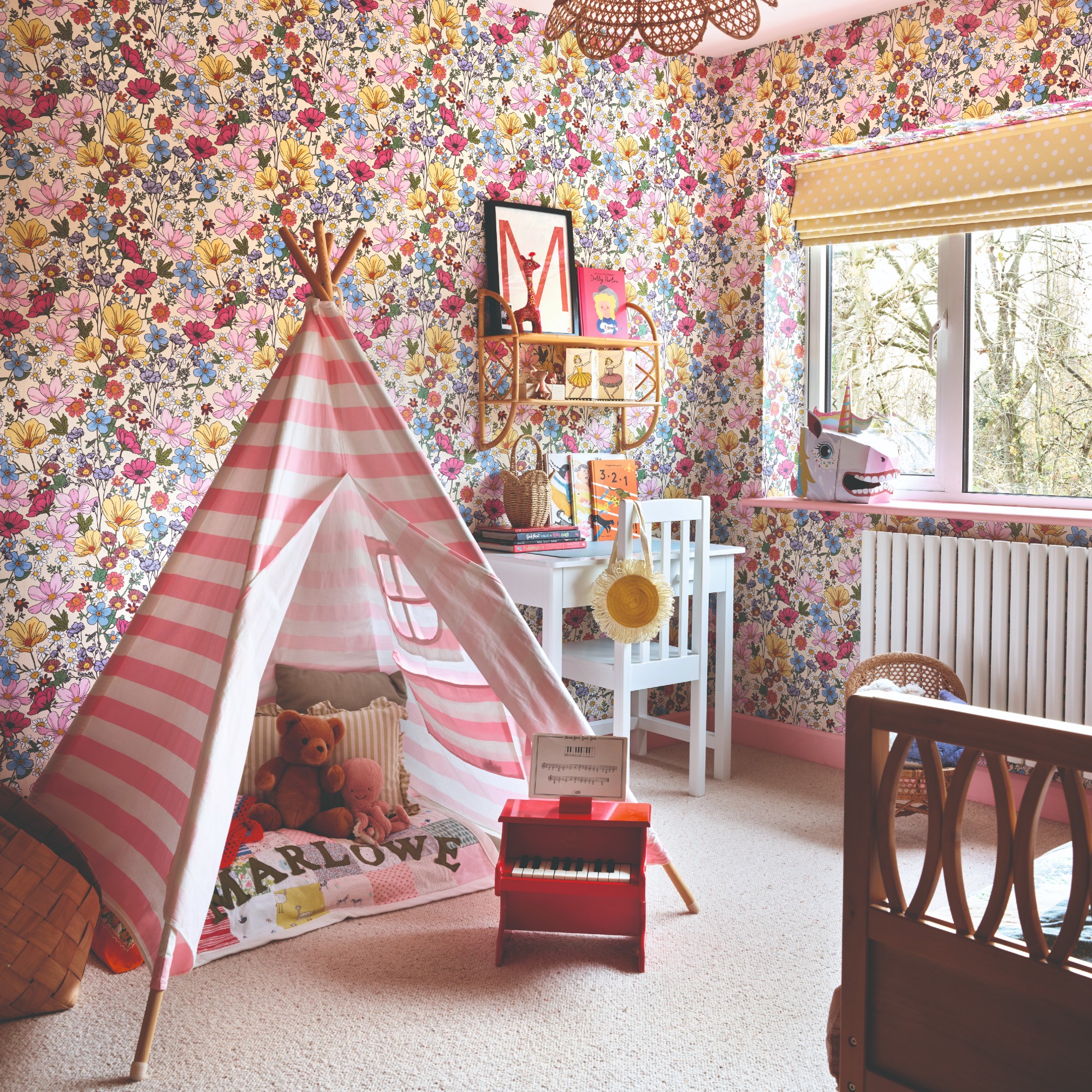
It’s important to properly zone the playroom in order to guide your children and inspire them a little as to what activities they can do in the space, even when you’re not around.
‘Creating distinct zones is essential. You’ll want a lively space for energetic play, such as building blocks or soft play mats, alongside a cosy corner for crafts or reading, Sam at Flitch says.
4. Choose the flooring carefully
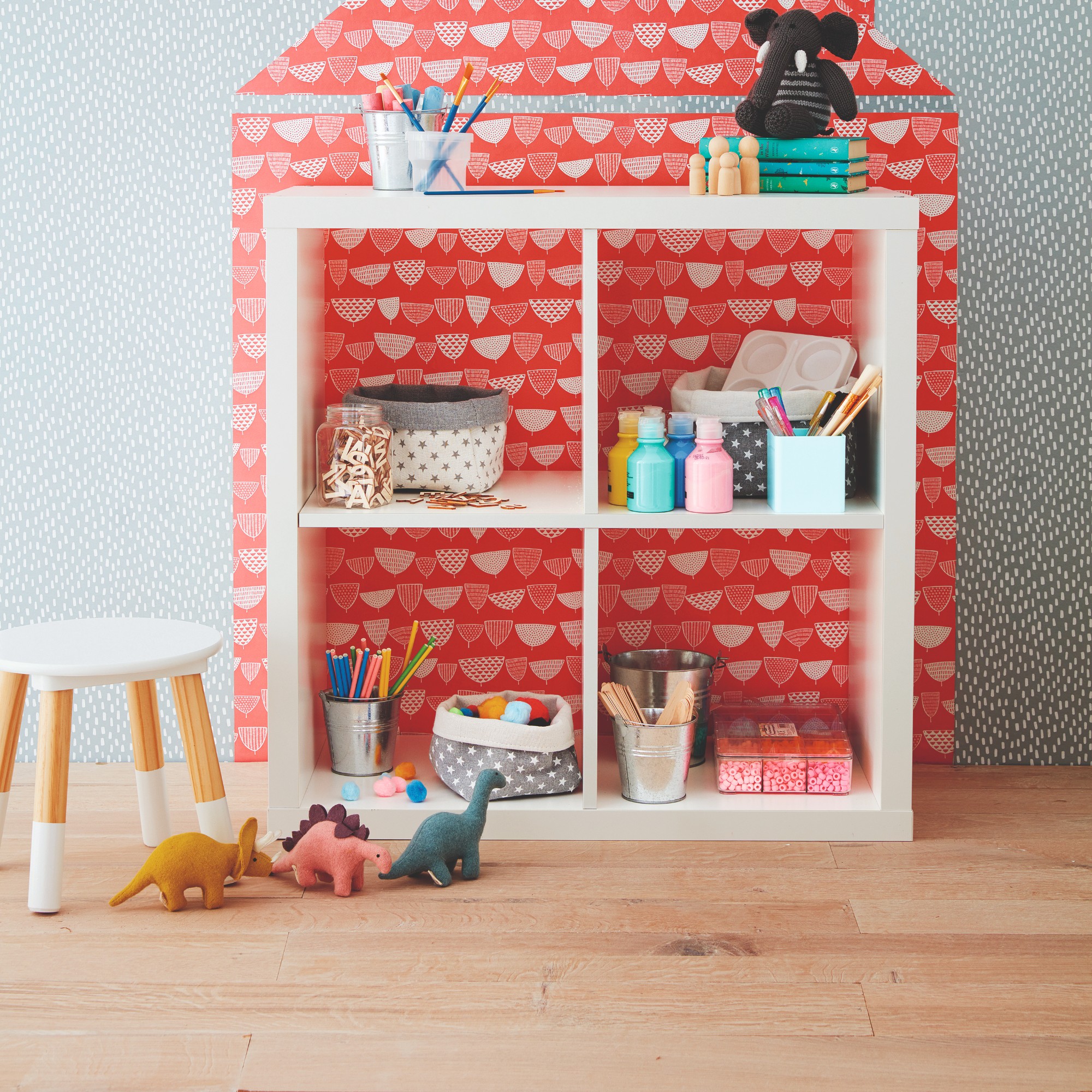
‘The foundation of an adaptable space is the floor,’ explains Anastasiia Kudashova, lead design manager at Quick-Step. ‘Arguably, it may be the only interior choice that will not need to change as the user matures.’
But since the flooring choice is likely going to be the most long-term one in the playroom, it’s important to pick wisely.
‘It needs to provide the perfect backdrop to early learning, yet offer a mature perspective as the teenage years approach. Instead of choosing what may seem like the fun option at first, why not opt for more neutral tones and designs that stand the test of time? And who wouldn’t want a playroom floor that’s easy to clean and hard-wearing? After all, it’s likely to experience an abundance of scratching, dirt, and any of the other messes of daily life that are only heightened by a child’s curiosity. Laminate and vinyl floors do just that, and can have natural-looking design that’s both inviting and comfortable,’ Anastasiia advises.
5. Choose a colour scheme
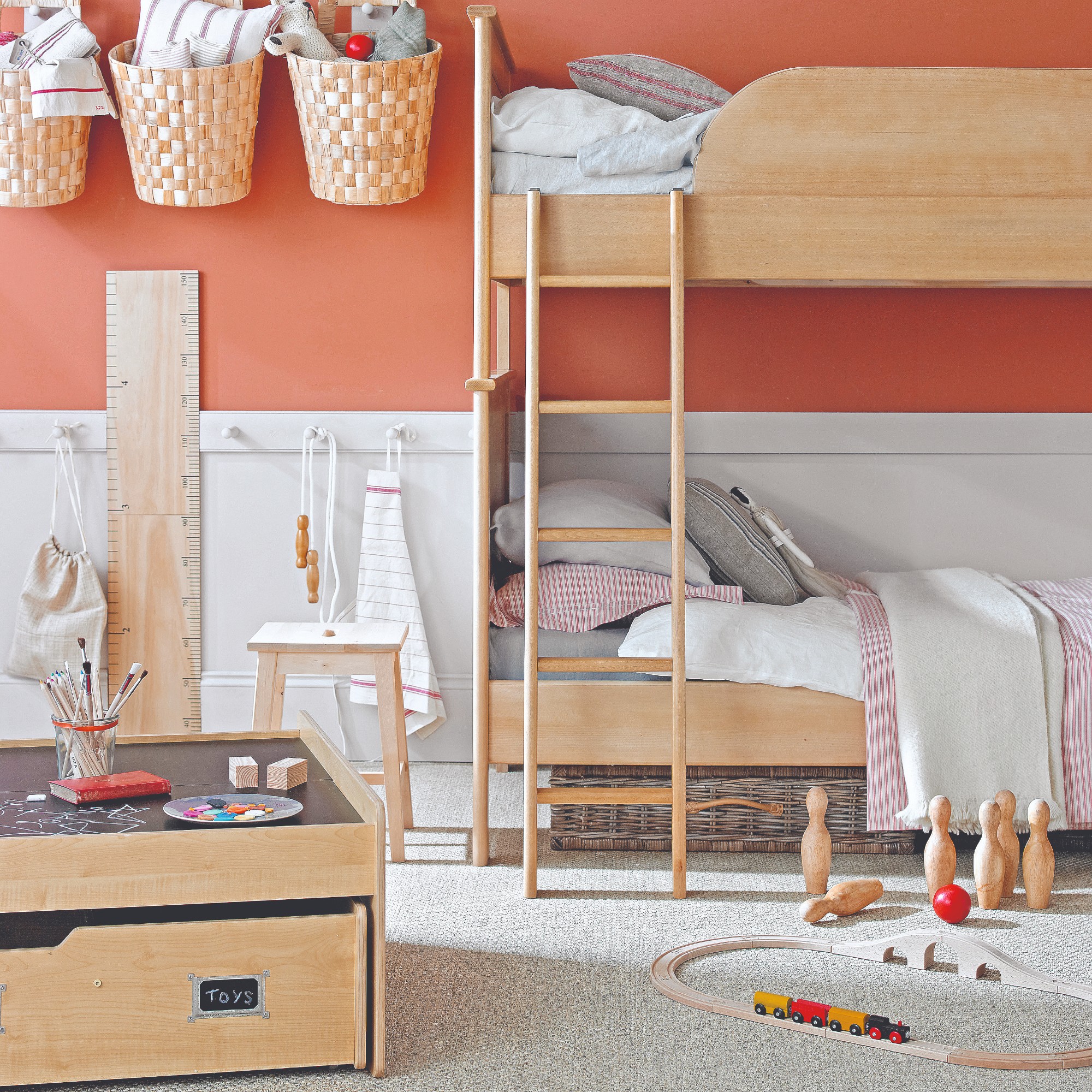
Even though this is a space reserved solely for your children and their play time, choosing a colour scheme and sticking with it will determine the effect the space will have on them. And it’s also worth noting that just because something is meant and designed for children it needs to be tacky and overly colourful. Also keep in mind some of the calming colours that are best for children’s bedrooms.
‘What excites and stimulates each child is personal and changes as they grow,’ says Esme Amberg, head of design at The Roost. ‘The space often starts with soft, soothing pastels, but soon moves on to boldly coloured Lego and an overload of colour. Yellow is often a safe bet. It adds an upbeat and sunny atmosphere.’
Jade Crow, nursery buyer at Jojo Maman Bebe, continues, ‘I would go with natural, earthy tones and accessorise with fun posters from your favourite illustrators. Calming colours that are not too garish – you want the toys to stimulate their senses.’
6. Bring in elements of the playground

The playground tends to be one of the favourite places for a child. So why not bring some small elements of that into their playroom? Whether that’s an indoor swing (or a swing chair which can also double as a reading nook), a ladder or a small slide.
‘You could recreate your own indoor park with a slide and ladder set if you have the space – perfect for those rainy days when you can’t get outside,’ says Shadiece Mitchell at premium Scandinavian furniture brand, Stokke.
Sam at Flitch agrees, ‘If you have the room, consider installing a mini climbing wall or hanging a swing from a sturdy ceiling joist to transform your playroom into an exciting adventure zone.'
7. Make the space cosy
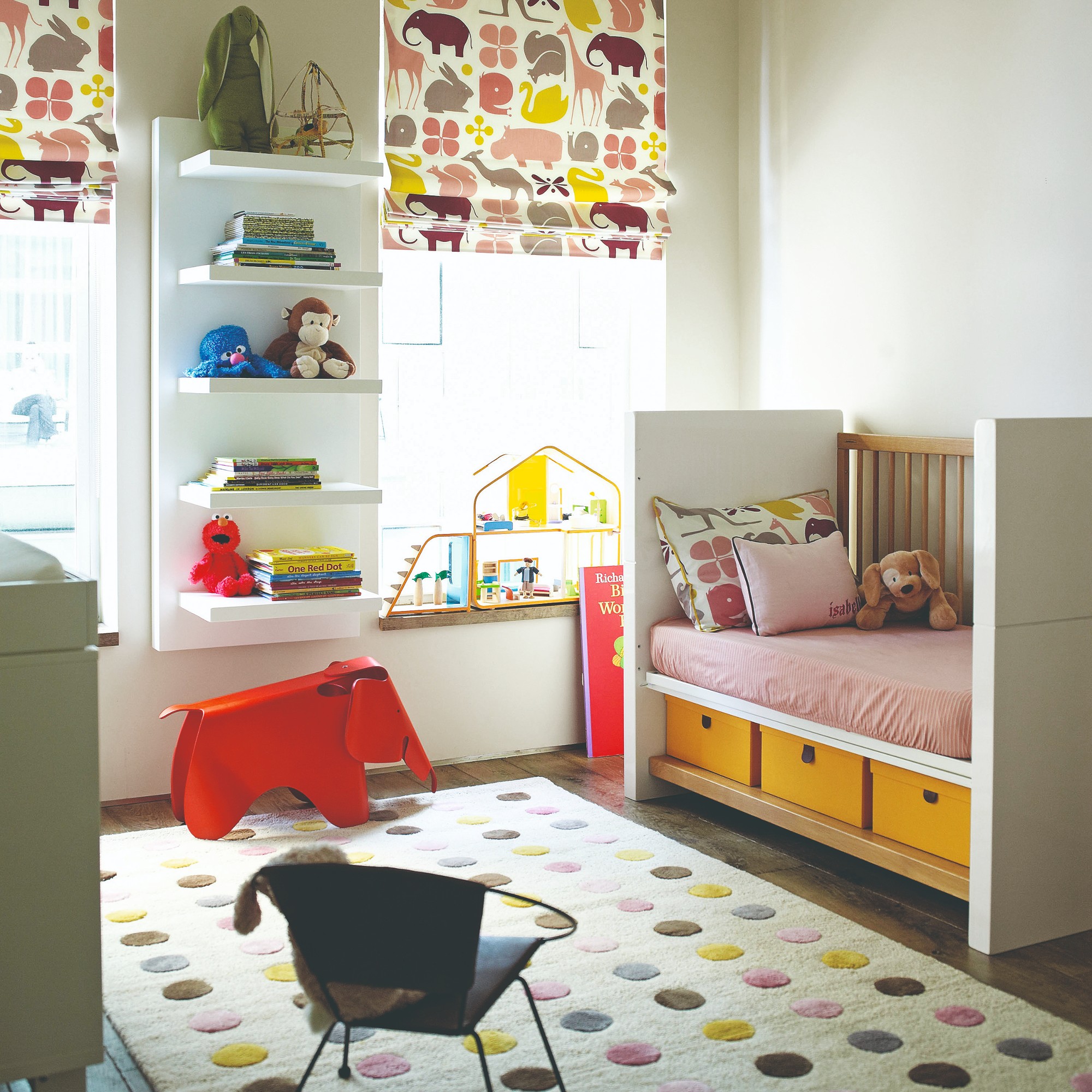
Since this room is sure to have a lot of different uses and your children are bound to spend a lot of time in here, it should be a welcoming and a cosy space they actually want to be in. And this is best created with the help of textures and the right lighting.
‘To create a cosy playroom, focus on comfort and warmth,' says Alex Tolofson at Nöa & Nani. 'Soft rugs, plush cushions, and bean bags can create inviting seating areas for relaxation and quiet play. Use warm lighting, such as fairy lights or lamps with soft-glow bulbs, to create a soothing ambiance. Incorporate textiles like blankets and curtains to add warmth and texture.’
8. Rotate toys and regularly declutter
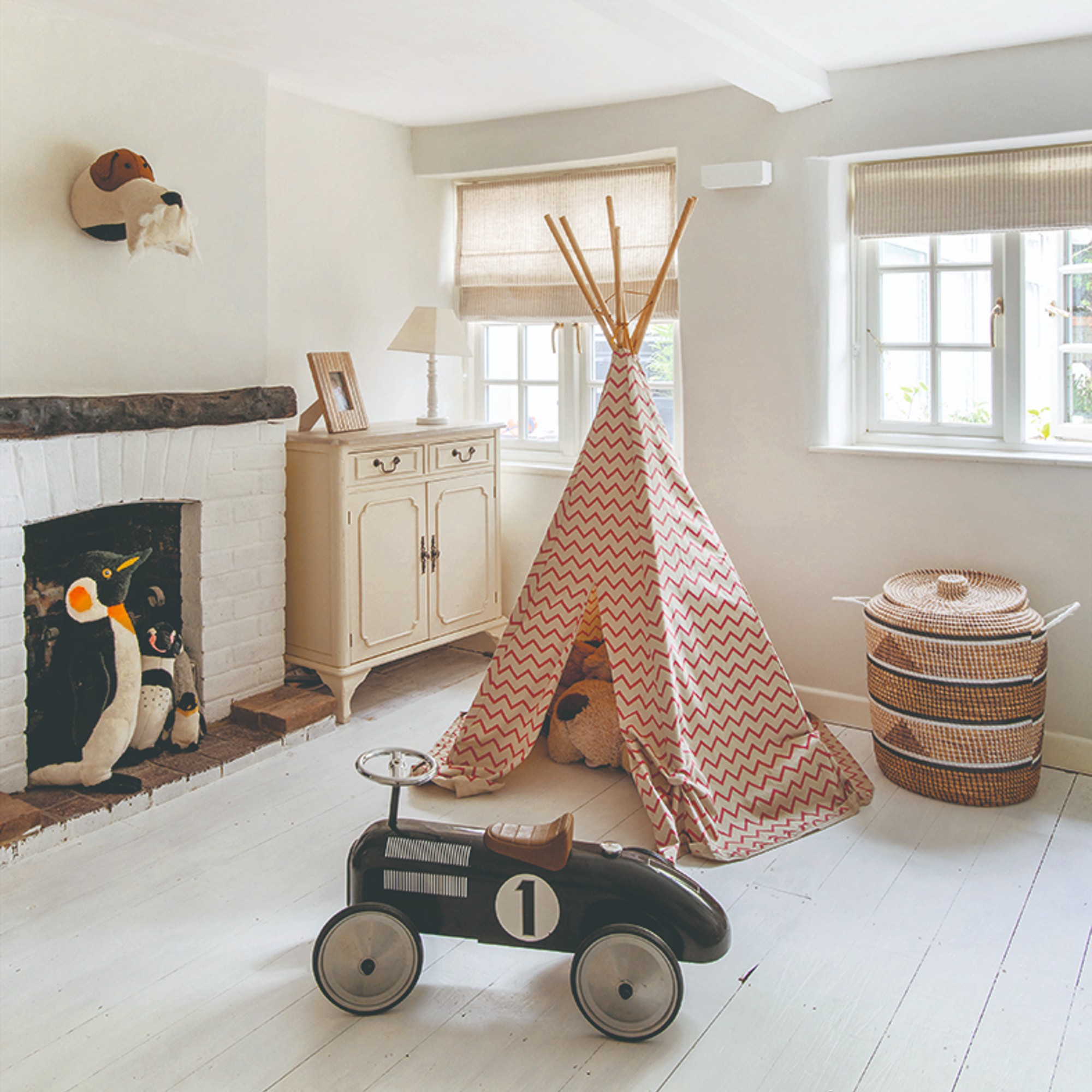
Just like any space in your home, you need to regularly declutter the kids’ bedroom and playroom too. And introducing the concept of toy rotation to keep them engaged with their playthings is also recommended by experts.
‘It’s a great idea to swap toys in and out so they don’t get bored and feel excited when they see their favourite toys again. So, if you have the space, I would recommend storing some toys in another room ready to swap in when you can,’ Shadiece says.
Alex adds, ‘Regularly declutter by donating or storing toys that are no longer used. Implement a clean-up routine to encourage children to put away toys after playtime.’
9. Create a den for children to play in
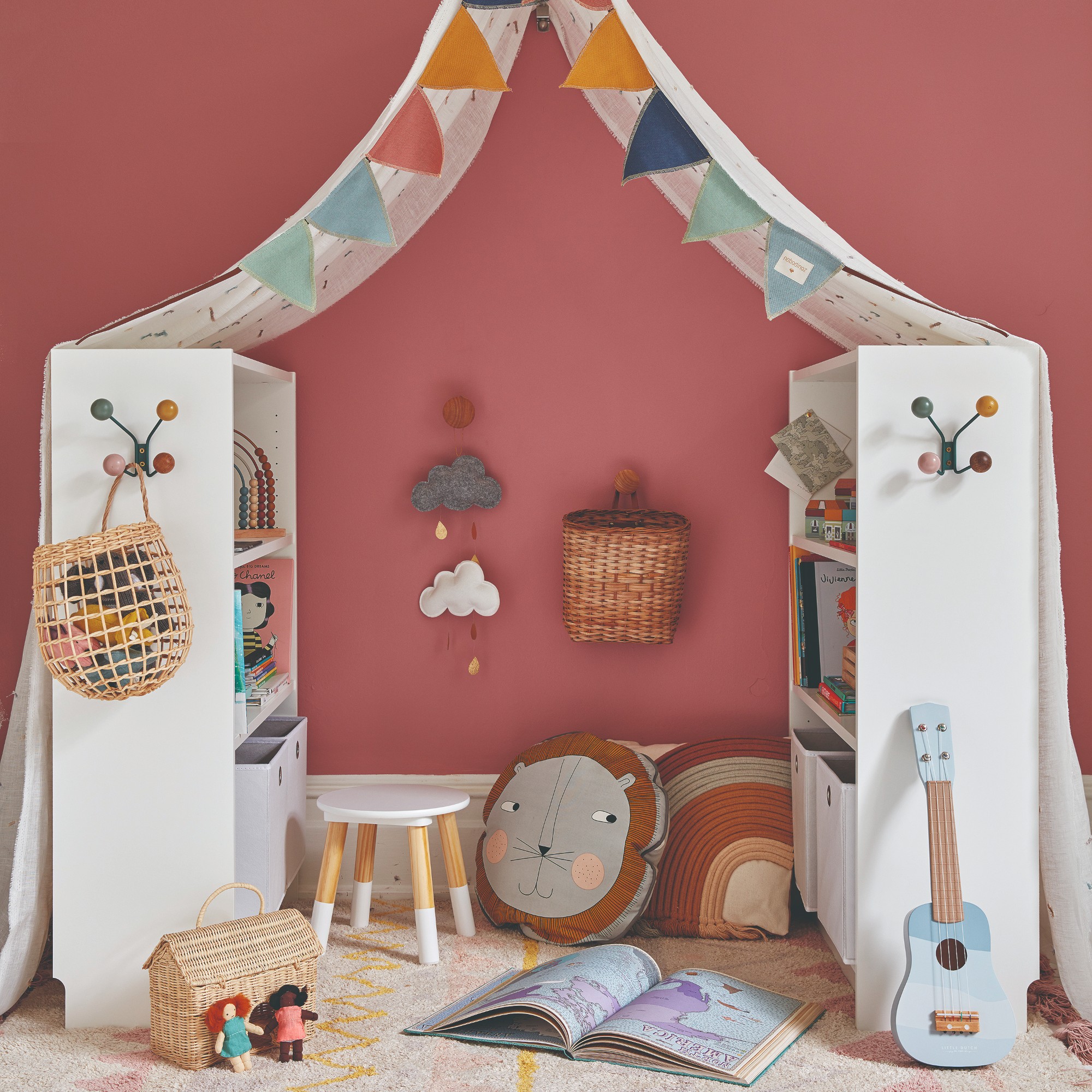
Create an area that will ignite your kids imagination with a cosy tent and a play kitchen. Children love nothing more than building a den, but protect your sofa cushions by creating a fabric teepee for your little nippers to play in.
There are plenty of children's tents to buy online, or why not have a got at making one with your children which they can personalise with fabric pens and offcuts.
'Add some imaginative touches to your space! A fabric canopy draped over a beanbag can create a cosy hideaway,' Sam at Flitch says.
10. Display fun artwork

Colourful artwork is a must in children's playrooms as it motivates, inspires and makes a fabulous feature to work around. Katie Thomas, founder of interior design company KTM Design explains. 'First and foremost, design the space for children – not adults. Play with patterns, colours and textures – children learn by observing and exploring their surroundings...Create a focal point and revolve your design around it.'
This brilliant red 'zoo' poster jumps off the soft grey background and is enhanced with colourful vintage-style schoolroom chairs and bright toys.
11. Enlarge the feel of a small playroom
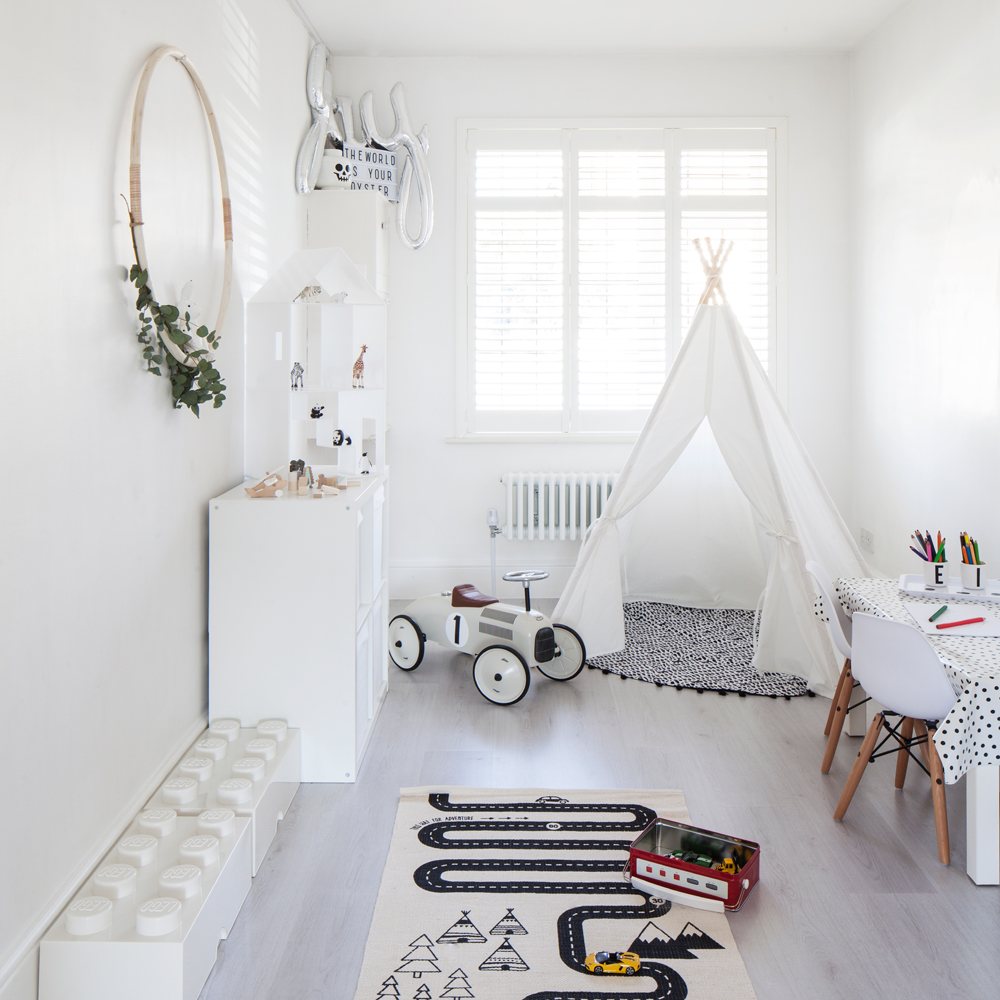
If your child or children are lucky enough to own a separate playroom there's a good chance it will be smaller than their bedroom. Make the most of the compact space by choosing a bright and balanced colour scheme that makes the most of light. This playroom with white backdrop and grey flooring is Scandi cool with monochrome fabrics to add depth and texture.
Plain white walls are practical too as they can be easily touched up with spare paint if marked and scuffed from all that play.
12. Include a homework hub
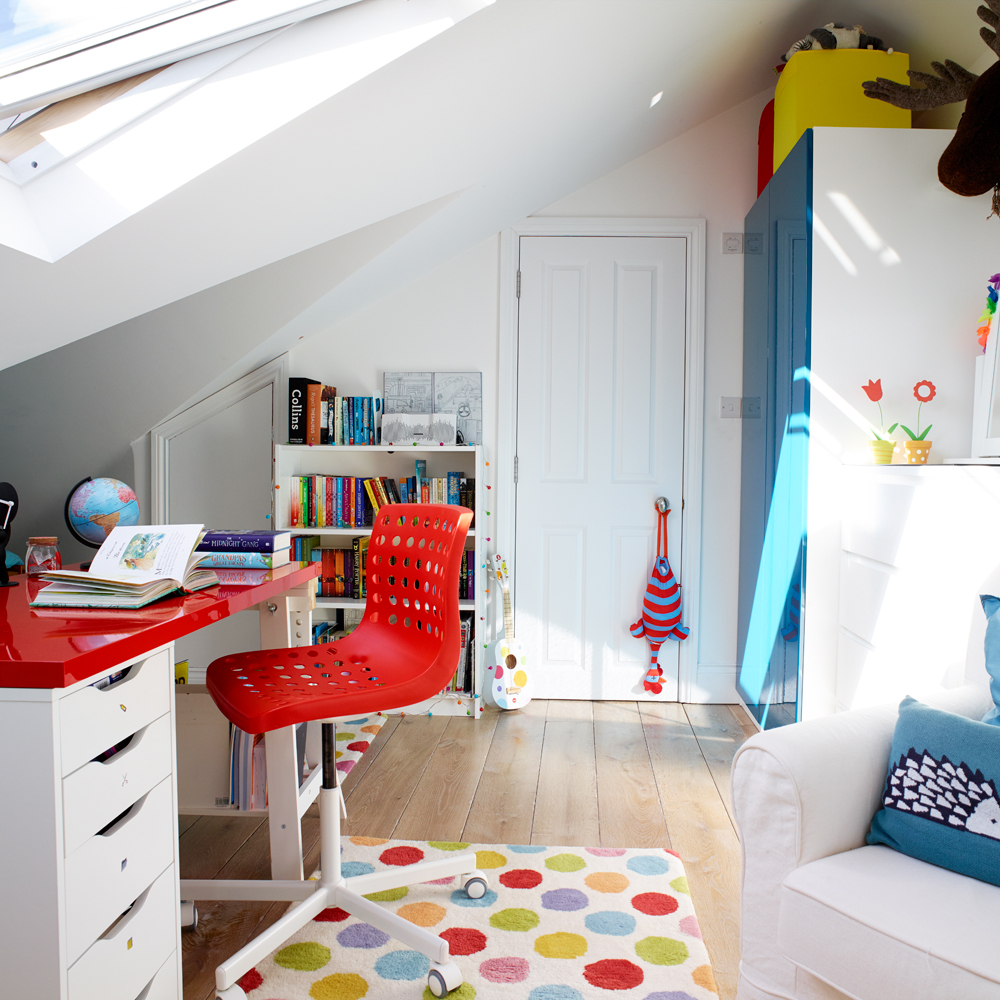
As home-schooling is more common, adding a dedicated desk for study a is practical playroom idea. Set up a zone with a sturdy desk and drawers in a light-filled space to motivate your little student. Keep the surface organised with personalised stationery and a notice board for reminders will add interest and colour.
A comfortable desk chair on wheels will make accessing bookshelves easy and fun too.
13. Introduce natural texture
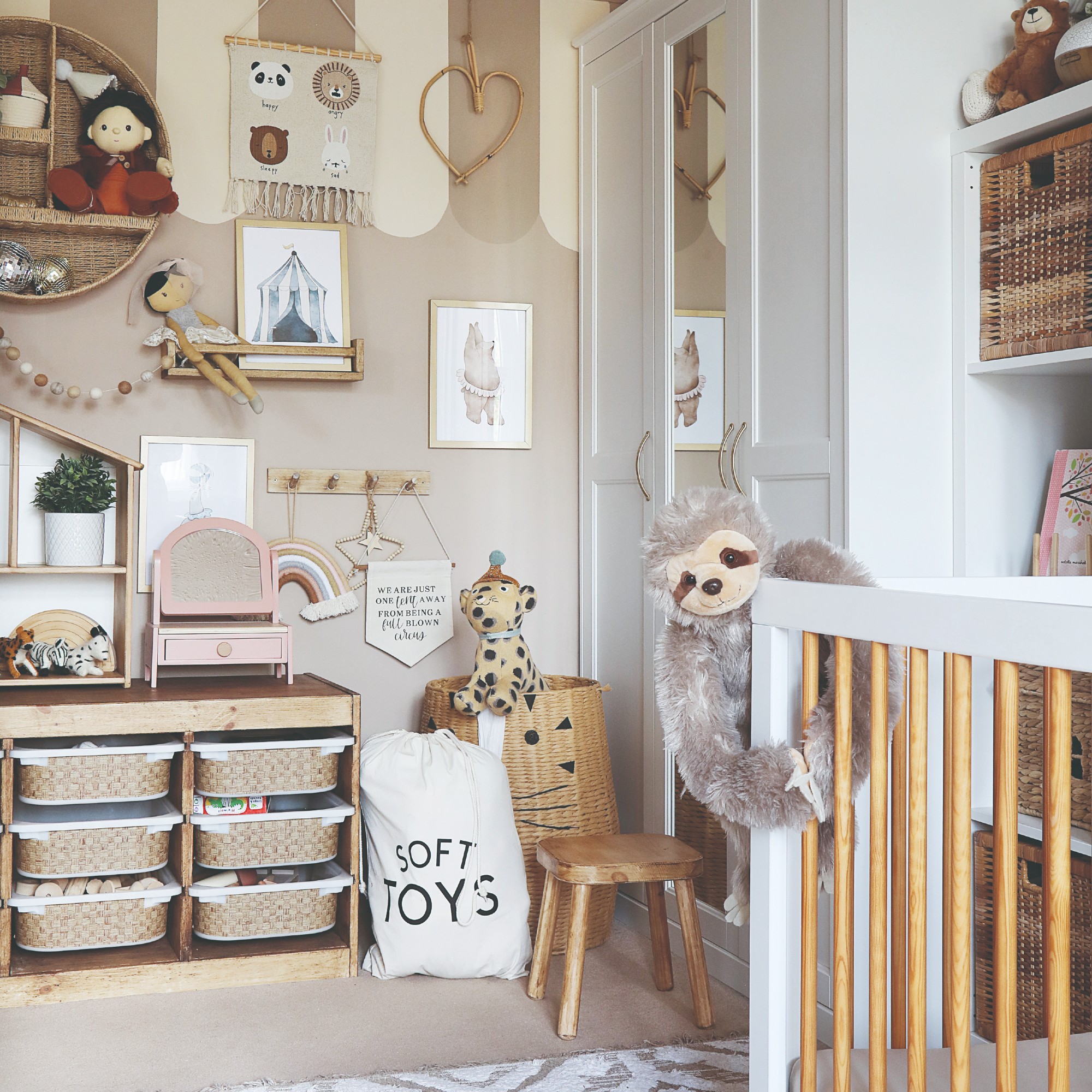
Whatever your playroom design idea, include plenty of natural materials to add texture, warmth and comfort. It's also a sustainable option; this cute house-shaped rattan bookshelf offers plenty of easily accessible open shelving for toys and storage baskets. Make sure it is safely secured to a wall or floor and continue the look with wooden storage with child-friendly non-toxic paint finishes.
14. Add a 'chill-out' chair
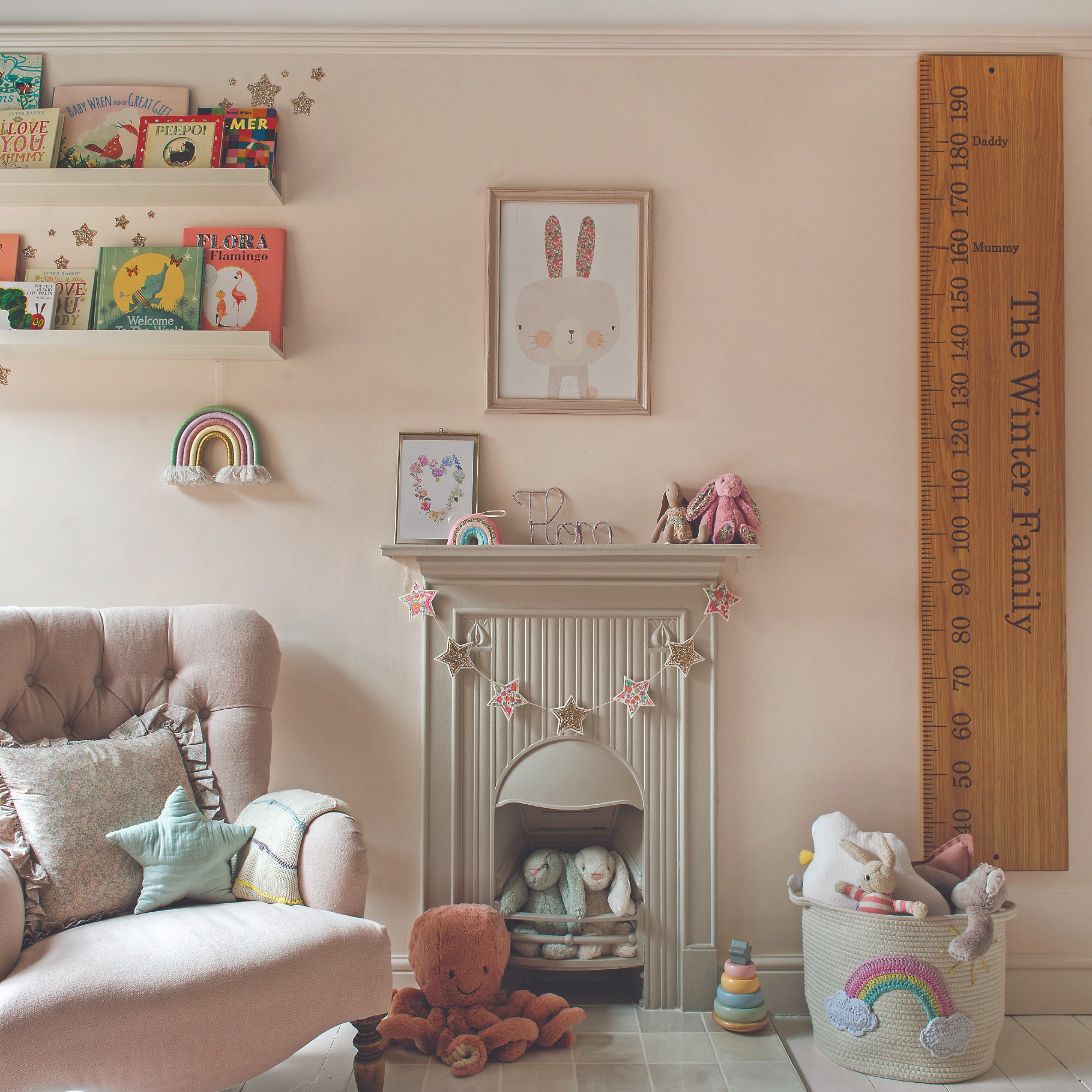
Providing a comfortable spot for downtime is almost as important as a recreation area in a playroom. A soft armchair or sofa will offer a calm and inviting vibe to a playroom which can often end up looking like a room of toy chaos otherwise. Include plenty of soft cushions and blankets for snuggle time too.
15. Make it multifunctional with a daybed

If you have space, a daybed or sofa bed is a good option if there is room as then the playroom can double as an extra bedroom idea for sleepovers if needed. Bean bags are a good low-budget option, too. Choose a daybed with storage underneath to store extra pillows, linen and fresh fluffy towels for little guests.
16. Put together a dressing up corner

Dressing up boxes might be perfect if you're short on space but why not make a feature out of your little ones princess dresses. Attach a hanging rail to the wall and display the dressing up collection so your daughter or son can transform into their favourite princess or superhero at a moment's notice.
It will also help keep the outfits looking as good as new for when their birthday and halloween come around.
17. Create a blackboard wall or cupboard
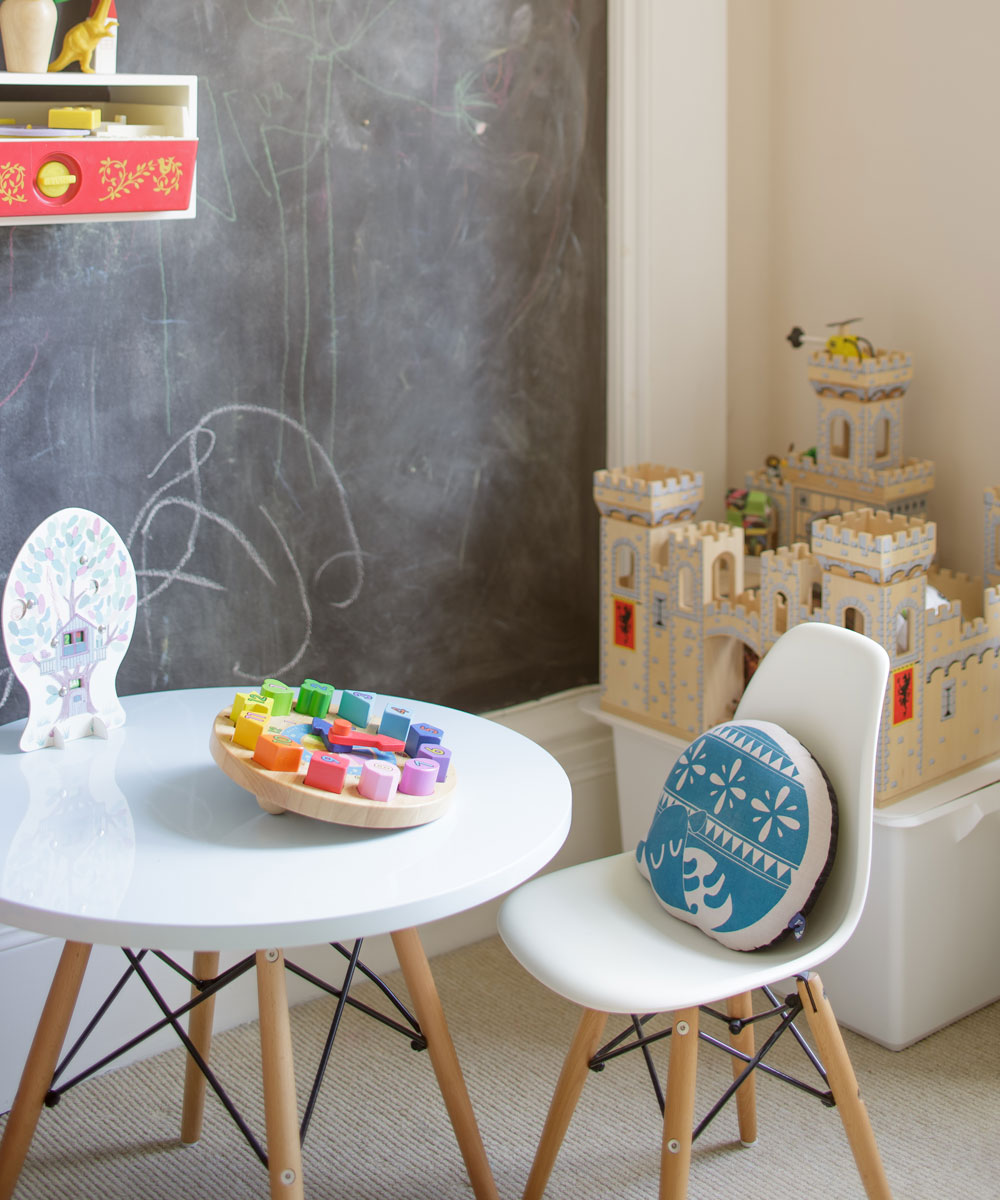
Let's face it, occasional scribbles on your freshly painted white walls can sometimes be an inevitable part of having small children in the house. So think how pleased they will be when they are actually allowed to do it!
A blackboard wall or cupboard door is not only a fun playroom addition, but the block of strong colour also looks striking against a white background. If messy chalk dust isn't your thing, try whiteboard paint, which has the same function but is a wipeable surface for washable markers. Team with an array of bright accessories to add colour to the playroom.
18. Factor in plenty of toy storage
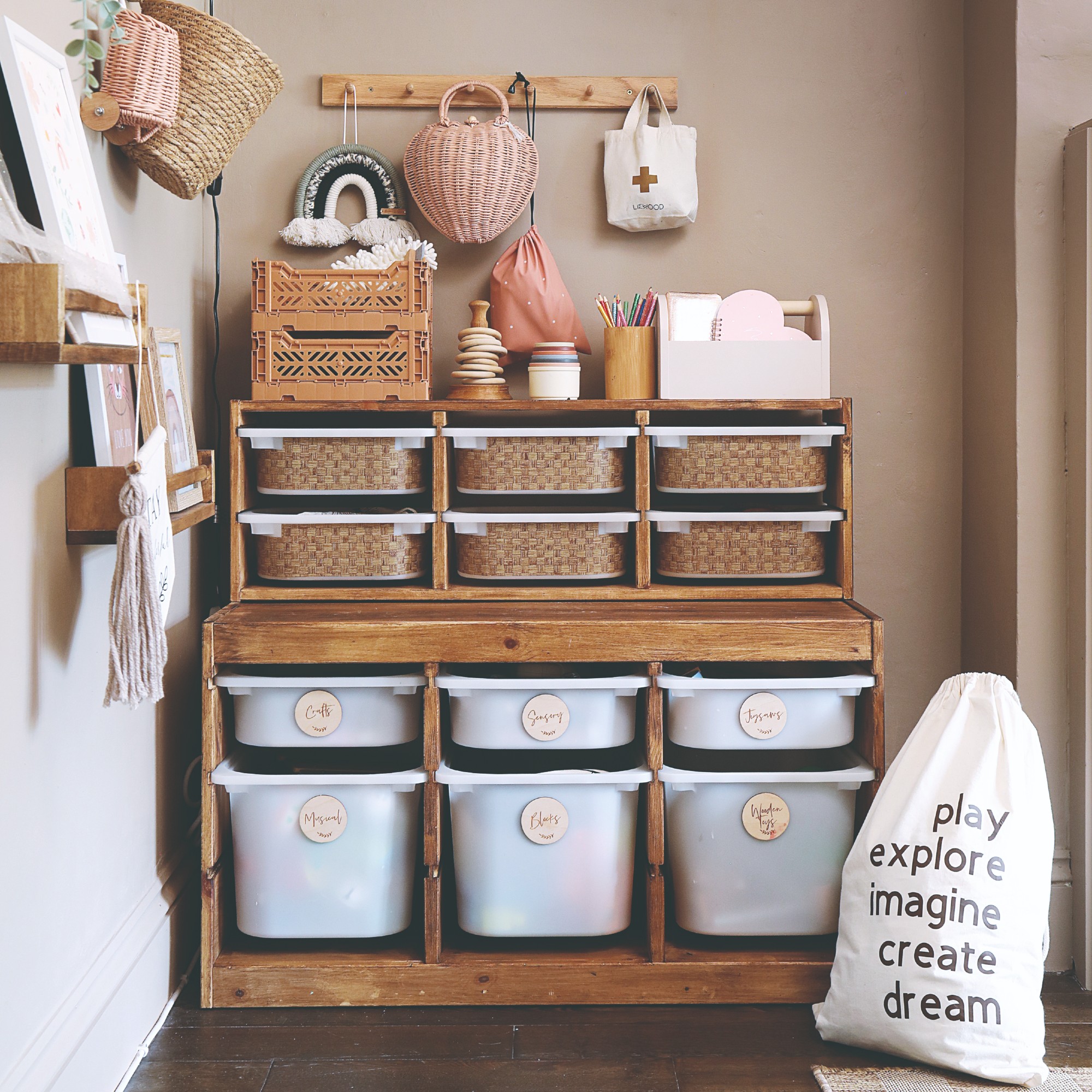
A playroom needs plenty of toy storage ideas to avoid the mess that an abundance of toys can create. But luckily, there are many storage solutions to choose from that you can also combine.
'Baskets, crates, and clear labels are your go-to helpers. If your children are not reading yet, try using picture labels so they can easily find where everything belongs. I am a big fan of IKEA’s TROFAST or KALLAX units with pull-out boxes, Sam at Flitch shares her IKEA playroom ideas.
19. Use wallpaper offcuts to update a white wall
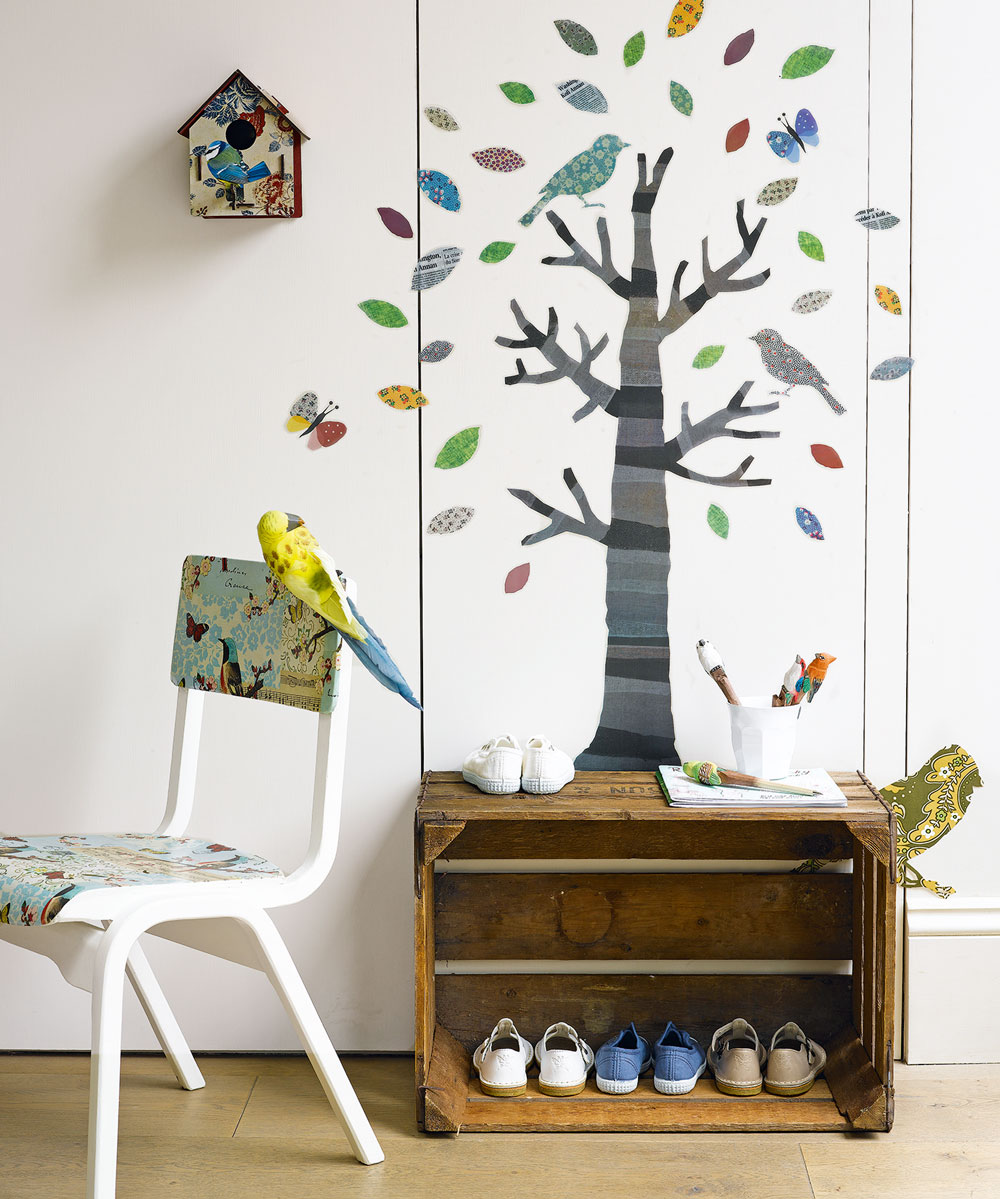
If you want to keep the walls fairly plain, a stand-out feature such as a decorative sticker can add a burst of colour and a playful element, without requiring the room to be totally redecorated as your child grows older. Here, a woodland sticker can even double as a height chart. Carry on the theme with toy birds and a pretty birdhouse to encourage a love of nature.
20. Furnish your playroom with pint-sized furniture
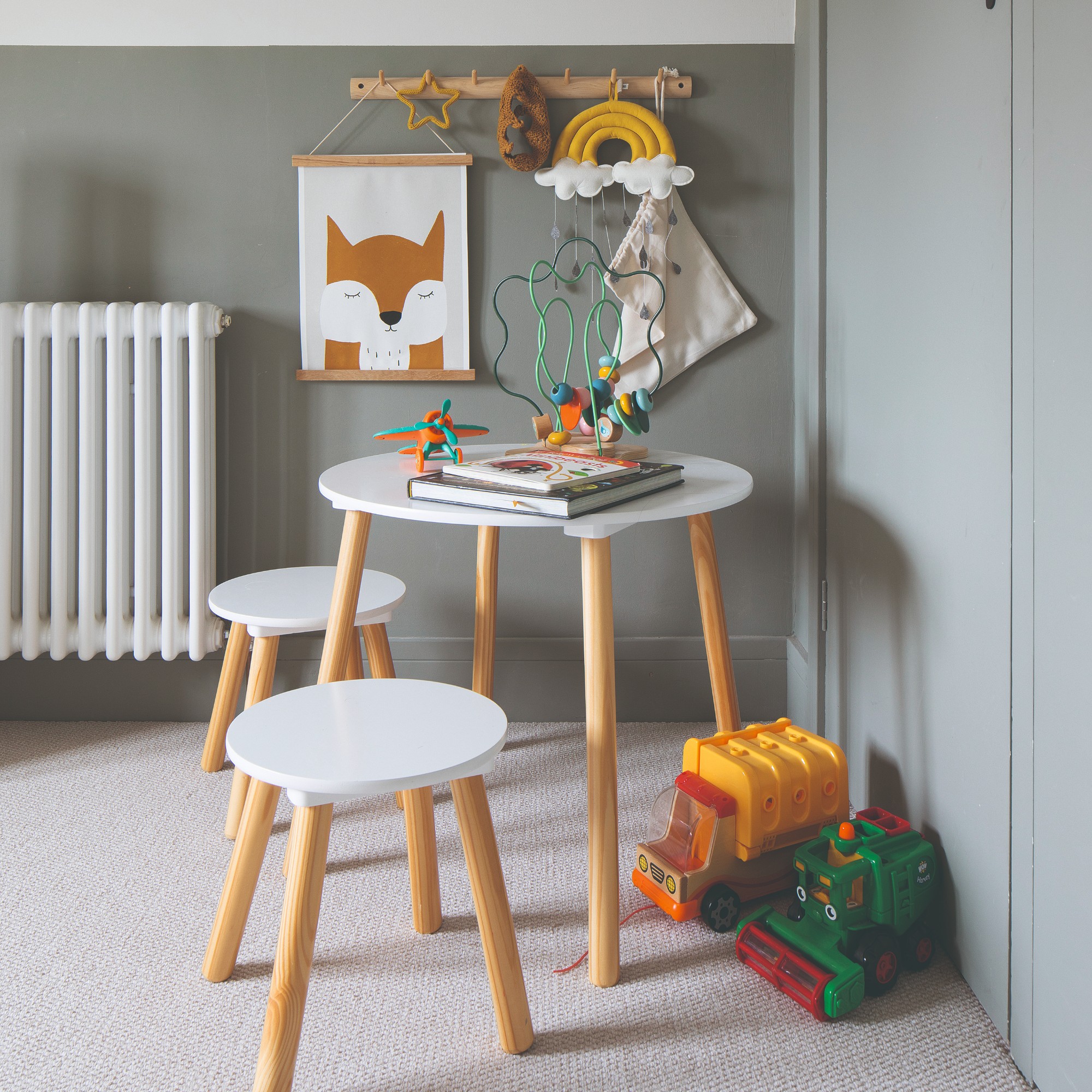
Playing on the floor all the time is no fun - it does little knees no good - so pave the way for school with a dinky sized table and chairs that are perfect for doing jigsaws, or painting and drawing. And this retro table and chair set ticks all the style boxes as it's an on-trend grown-up design scaled down for tots. Choose furniture in white and it's guaranteed to work in any scheme, whether a boys or girls bedroom idea.
21. Invest in a unique bed
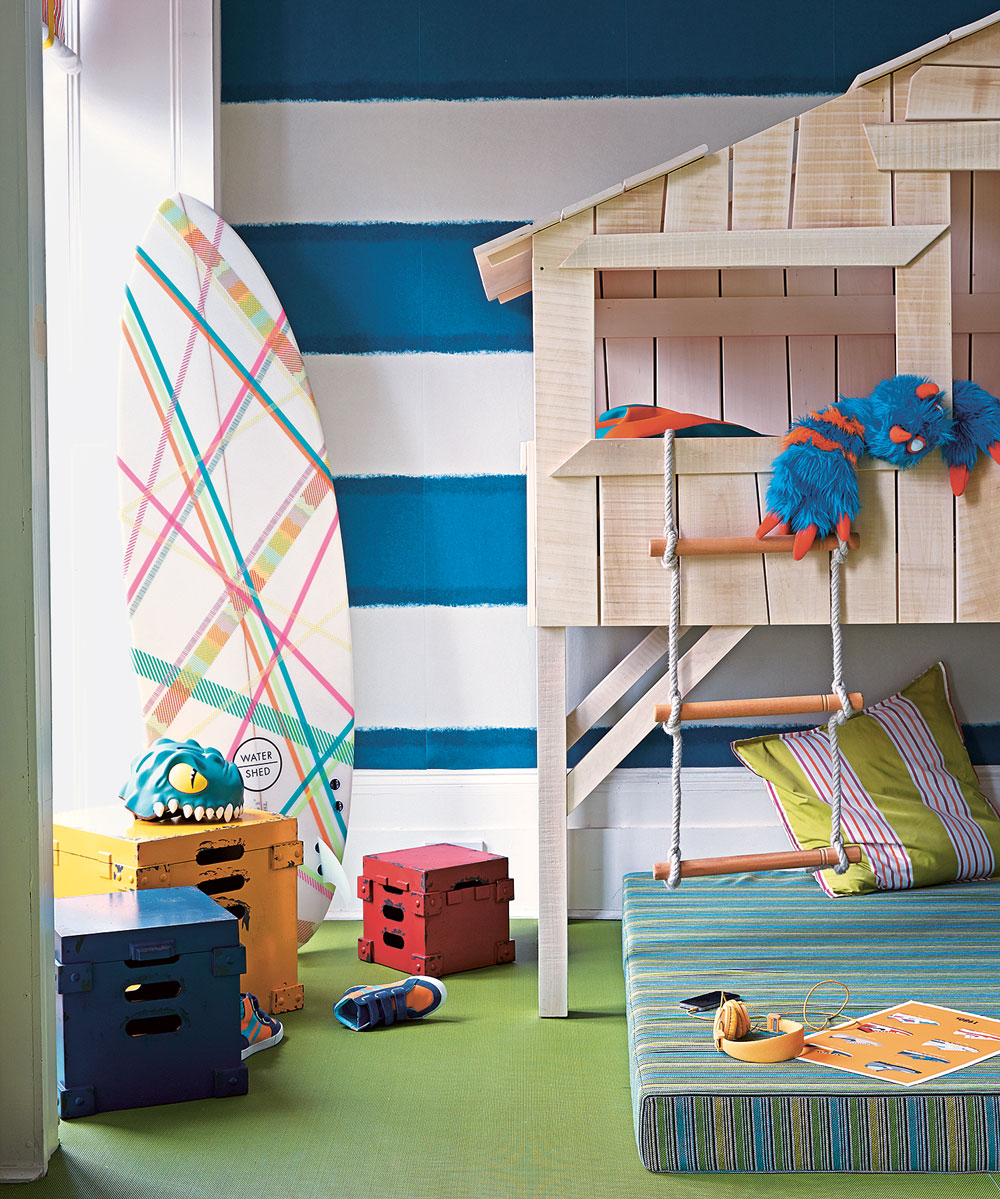
Be creative with furniture or try adding a tent or den. Here a cabin children's bed has been turned into its own capsule playroom in the form of a timber treehouse-style structure ready for adventure. Vibrant blue-and-white striped walls ooze creativity and vibrancy, while a quirky coloured mattress makes a modern alternative to chill-out bean bags. A funky green rubber floor gives the impression of grassy fields and makes a safe alternative to hard floor.
22. Incorporate low-level furniture
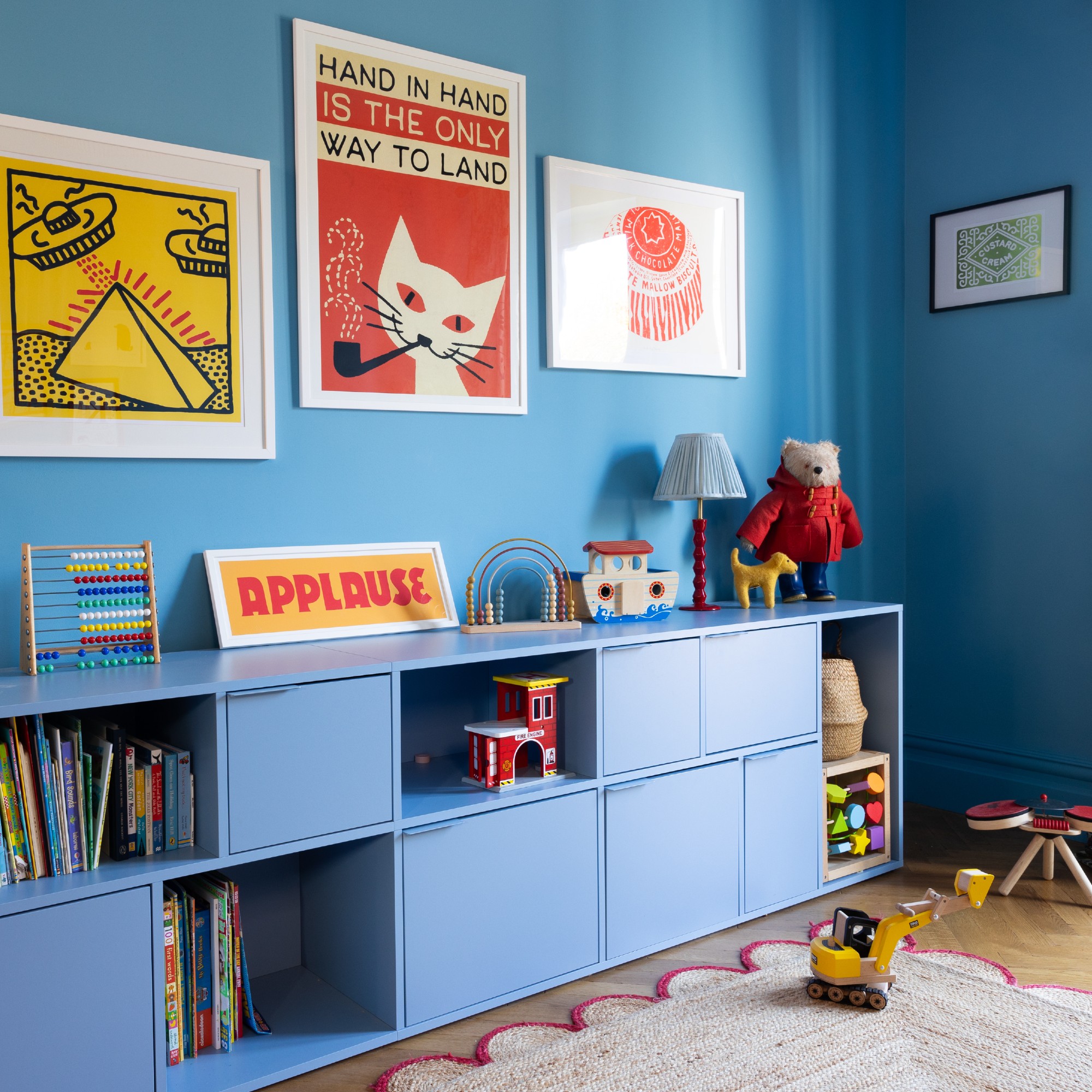
Accessible storage at the right height is a key element for keeping the room organised and inviting little ones to help tidy the space. Zone it off and arrange it by theme, so it is simple for children to identify what goes where. Keep it low level so it's easy to access (and tidy away) and perhaps incorporate the storage into spaces, such as under a window to make sure it's tucked away.
23. Create a cosy reading nook
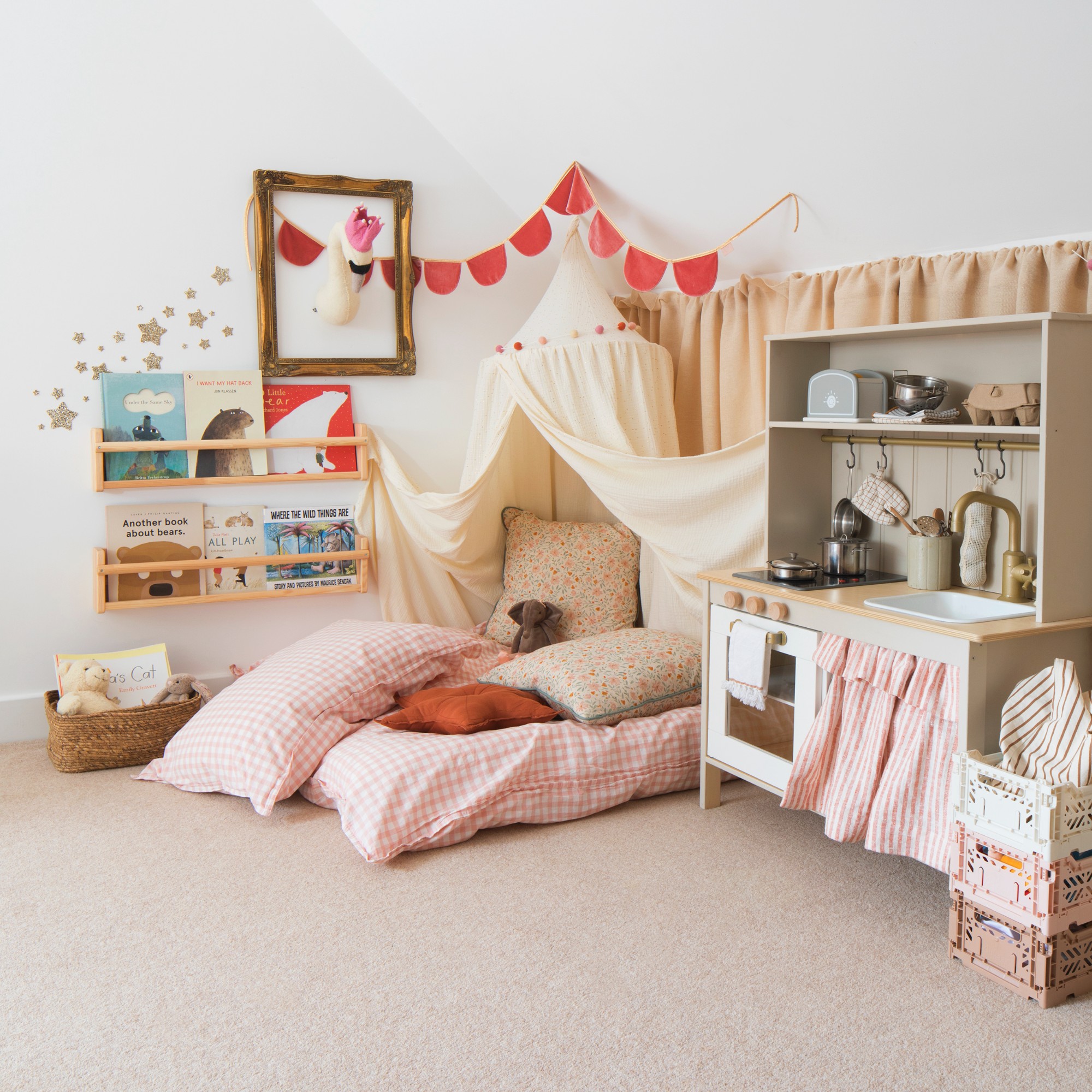
Reading and picture books are a vital part of your child's development and giving them a playroom with a place to take time out and practice there reading is just important as a space for lively play. Find a light corner and fill it with plenty of accessible books. Then make the area inviting with soft seating, cushions, bean bags and perhaps a cuddly friend or two. The wooden letters on the shelves are a perfect addition if your child is still learning to read and occasionally needs a little extra help with there letters.
24. Make it memorable
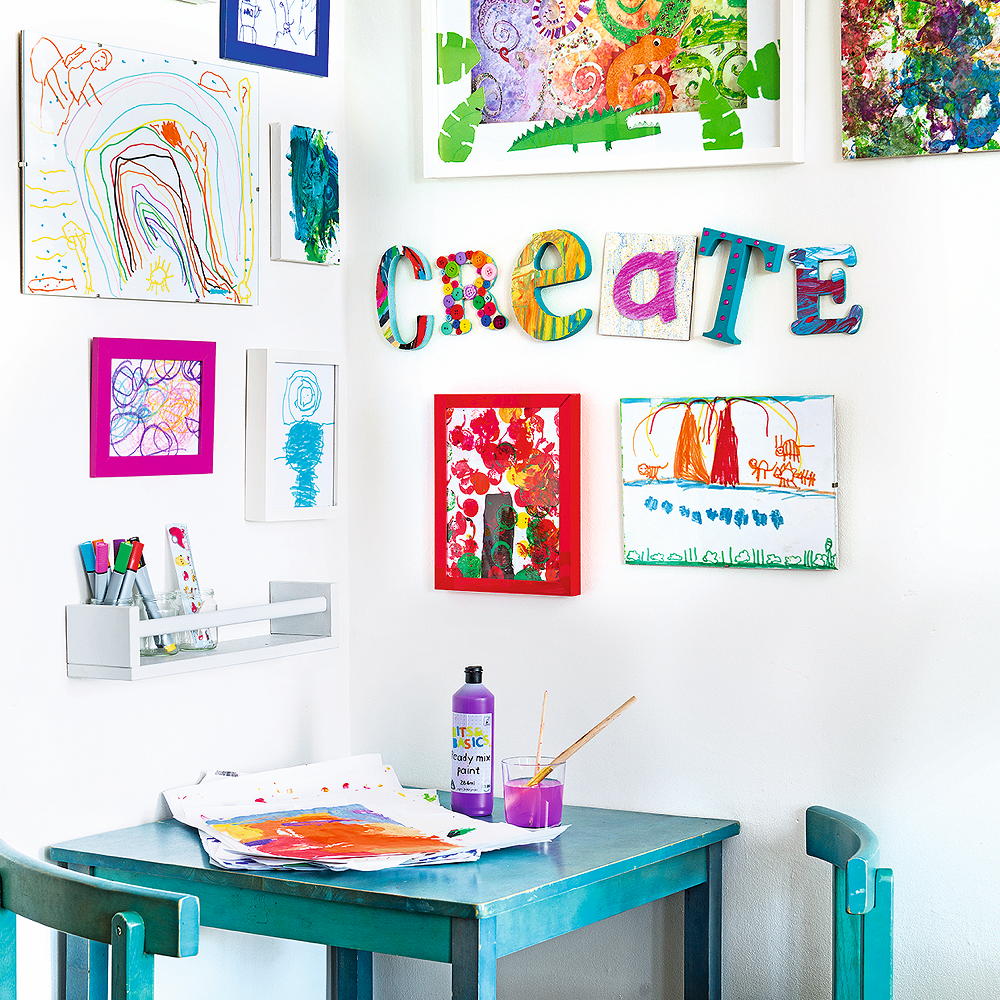
Displaying children's treasured artwork is a must, create a corner where they can be shown off. A table beneath makes it easier for little ones to get involved. Add colourful frames that can easily be updated. Lengths of string attached to the walls and pegs is a great playroom idea for fresh drying paintings.
The teepee is the most classic of children's play tents but no less charming. And you as a parent will surely be charmed by the extremely affordable price point of £13.99. No wonder over 300 of these sell on Amazon every month.
Who said that storage baskets need to be boring? We sure didn't because we're madly in love with this toadstool storage basket from Dunelm that is still tasteful owing to its natural material and neutral colours.
When it comes to natural materials, it's not just all about rattan. Wood, wool, linen and cotton are among many others that you can incorporate. Case in point, these 100% cotton curtains with a sweet hot air balloon print.
A bean bag is a great addition to a playroom as it provides a soft, cosy texture, along with a spot for reading. And this Kaikoo design from Argos comes in five different colours for you and your little ones to choose from.
A playroom rug is not only for texture but also for imaginative play so be sure to choose a fun design like this one from PractiRug. And to combat children's messes and sticky fingers, it's best to opt for a washable rug which this style is, too.
If you're ever after aesthetically pleasing, Scandi-style children's furniture and decor at affordable prices, then look no further than H&M. This sleek wooden toy storage bench is the perfect example - and it comes in seven different shades to pick from.
FAQs
What should be in a playroom?
Playroom essentials include organised and hidden toy storage ideas that are safely secured and easily accessible for children to reach and tidy themselves when encouraged. As floor play is a vital part of children's development cushioned mats, soft rugs and oversized floor cushions are a good playroom idea.
A small table and chair are practical for crafting along with a set of drawers for supplies. Lastly, older children will benefit from a desk and notice board for homework and academic interests.

How do you make a playroom in your living room?
Allocating an area of the living room as a playroom may seem an extravagance but it will mean toys will hopefully be kept confined in one place rather than sprawled all over the house. Carve out a corner or zone that suits the rest of the living room scheme. Include a space for floor play, toy storage ideas that work even for small living rooms and if possible a surface for crafting and scholarly purposes.
'You can create a playroom within a living room by designating a specific area for play,' says Alex Tolofson at Nöa & Nani. 'Use furniture like bookshelves or storage units to create a boundary between the play area and the rest of the living space. Choose furniture that blends with your living room decor but is functional for play, such as a storage ottoman or a stylish toy chest. Use rugs to define the play zone and add a visual separation. Incorporate storage solutions to keep toys organized and out of sight when not in use.'
Perhaps by the end of implementing these ideas, you’ll want to spend some more play time there, too.







